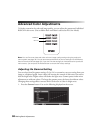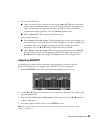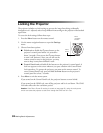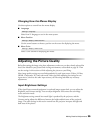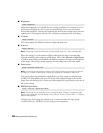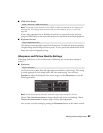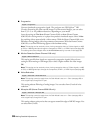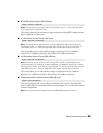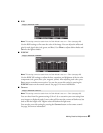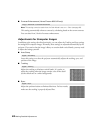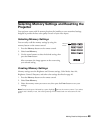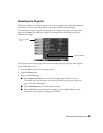
38 Making Detailed Adjustments
■ Progressive
Converts interlaced to progressive signals. The projector uses 3D DigiScan
™
HD
Circuitry Processing for video-sourced images. For film-sourced images, you can select
from 2-3, 2-2, or 4-4 pulldown detection, depending on your model.
Leave the setting on
Film/Auto (Home Cinema 6100) or Auto (Home Cinema
6500 UB) for viewing movies on a player that produces interlaced output. Select
Video
for watching videos captured with a video camera. With the Home Cinema 6100, set to
Off when viewing images with a large amount of movement. With the Home Cinema
6500 UB, set to
Film if flickering appears with the Auto setting.
Note: This setting can be used only when viewing composite video or S-video signals, or 480i
or 576i, or 1080i signals input through the Component, HDMI 1, or HDMI 2 ports (see page 68).
This setting cannot be changed while the 4-4 Pull-down setting is turned on (see page 39).
■ Motion Detection (Home Cinema 6100 only)
This setting specifies how signals are converted to progressive signals. Select a lower
setting for slow-moving or still images (
S) or select a higher number for video images
(
M).
Note: This setting can be used only when viewing composite video or S-Video signals, or 480i
or 576i, or 1080i signals input through the Component, HDMI 1, or HDMI 2 ports (see page 68).
■ Noise Reduction
Note: This setting cannot be used when the Color Mode is set to x.v. Color (see page 29) or
with a signal input through the PC port.
This setting reduces flickering of analog images. You can select from 3 levels of noise
reduction.
■ Mosquito NR (Home Cinema 6500 UB only)
Note: This setting cannot be used when the Color Mode is set to x.v. Color (see page 29) or
with a signal input through the PC port.
This setting reduces grainy noise that can appear around the edges of MPEG images. You
can select from 3 levels.
Signal > Progressive
Signal > Motion Detection
Signal > Advanced > Noise Reduction
Signal > Advanced > Mosquito NR



